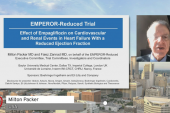Sotagliflozin Beneficial Across a Range of Patients, Including HFpEF
The pooled analysis from SCORED/SOLOIST-WHF hints at a potential reduction in CV death, but more data are needed.

Use of sotagliflozin, a dual inhibitor of sodium-glucose cotransporter 1 and 2 (SGLT1/2), significantly reduces the risk of cardiovascular mortality, hospitalizations for heart failure (HF), and urgent heart failure visits in patients across a range of ejection fractions, including those with heart failure and preserved ejection fraction (HFpEF).
Those are the conclusions of a pooled analysis from the SOLOIST-WHF and SCORED clinical trials presented recently at the American College of Cardiology 2021 Scientific Session.
When the two trials were combined—SOLOIST-WHF included patients with acute HF, while SCORED focused on patients with diabetes and chronic kidney disease with at least one major CV risk factor—there was a reduction in the risk of cardiovascular death and hospitalizations/urgent visits for HF. In the patients with preserved ejection fraction, defined as ≥ 50%, there was also reduction in the risk of cardiovascular mortality and hospitalizations/urgent visits for HF.
“These data are the first randomized data from a prespecified analysis of clinical trials that actually show a significant effect of a therapy on heart failure with preserved ejection,” said lead investigator Deepak L. Bhatt, MD, MPH (Brigham and Women’s Hospital, Boston, MA). That benefit was also observed in women.
Based on the evidence today, Bhatt said that, speaking broadly, SGLT2 inhibitors as a class should be used much more than they are being currently. “Most patients with diabetes, barring contraindications or access issues, should be on an SGLT2 inhibitor,” he said. “This is especially true if they have chronic kidney disease or if they have heart failure, certainly heart failure with reduced ejection fraction.”
While the combined analysis appears to suggest a potential role for sotagliflozin in patients with HFpEF, the definitive results will come from two ongoing clinical trials testing two other SGLT2 inhibitors—dapagliflozin (Farxiga; AstraZeneca) in DELIVER and empagliflozin (Jardiance; Boehringer Ingelheim) in EMPEROR-Preserved. Bhatt said there are basic science data suggesting SGLT1 inhibition, which is unique to sotagliflozin, might have particular benefits in these patients.
“However, my own feeling is—and I’ll predict that the empagliflozin and dapagliflozin HFpEF trials will be positive—that I do think there will be a class effect here with respect to SGLT2 inhibitors broadly, including sotagliflozin,” he said. “But we’ll find out soon.”
To TCTMD, Carlos Santos-Gallego, MD (Icahn School of Medicine at Mount Sinai, New York, NY), said the new data are “incredibly promising, opening a window of hope into the treatment of HFpEF.” Until now, he said, all trials testing treatments for HFpEF have failed. The US Food and Drug Administration has approved sacubitril/valsartan (Entresto; Novartis) for use in at least some patients with HFpEF, but the PARAGON-HF trial, on which the indication was based, missed its primary endpoint, albeit narrowly.
“To have a drug that would seem to improve outcomes in patients with HFpEF is huge,” Santos-Gallego told TCTMD. “It’s an unmet need and there are more and more patients with HFpEF. Given the epidemic of diabetes and obesity, we’re going to see an increase in the incidence of HFpEF, too. Obviously, [the combined analysis] is more hypothesis-generating at this point than conclusive evidence.”
Hint of a CV Death Benefit
Pooling data from 11,784 patients in SOLOIST-WHF and SCORED, the primary endpoint of CV death, HF hospitalization, and urgent HF visits was reduced 28% with sotagliflozin (HR 0.72; 95% CI 0.63-0.82). In the 739 patients with HFpEF, the reduction in the primary endpoint was 37% (HR 0.63; 95% CI 0.45-0.89). In an intention-to-treat analysis, there was no significant reduction in the risk of cardiac death in the entire cohort, but there was a significant 23% reduction in CV death in the on-treatment analysis.
Santos-Gallego said the consistent benefit of sotagliflozin across a range of subgroups—men and women, patients with and without a history of HF—suggests the data are quite robust. The treatment benefit across the range of EFs, specifically in HFpEF, “remains the crown jewel” of the new analysis. However, like Bhatt, he stressed that physicians will need to wait for results from EMPEROR-Reduced and DELIVER, which are scheduled for completion this year. As for the reduction in CV death in the overall cohort, Santos-Gallego said the on-treatment analysis has a number of limitations, but it’s promising. “Again, this must be confirmed in larger clinical trials,” he said.
Speaking after the late-breaking clinical trial session, Thomas Maddox, MD (Washington University School of Medicine, St. Louis, MO), said it’s particularly “gratifying to see some HFpEF therapies starting to bear fruit.” With respect to the reduction in CV death in the on-treatment analysis, he questioned whether the finding was real.
Bhatt said the analysis represents the best-case scenario, excluding patients who were unable to tolerate the drug, for example. However, he also noted that the intention-to-treat analysis trended in favor of sotagliflozin, and based on the aggregate data, including a recent meta-analysis, Bhatt said he thinks it’s a real finding: “I think even the intent-to-treat analysis with sotagliflozin would have shown a significant reduction in CV death if we had the funding to continue the trials to the full, planned direction.”
Lexicon Pharmaceuticals is proceeding with sotagliflozin after splitting with Sanofi over the drug’s development and has filed a new drug application with the FDA. The company is currently seeking approval of the drug as a treatment for patients with type 2 diabetes and either worsening heart failure or risk factors for heart failure.
“That aspect of things is progressing and I hope that the drug actually makes it to patients and can help them,” said Bhatt.
Michael O’Riordan is the Managing Editor for TCTMD. He completed his undergraduate degrees at Queen’s University in Kingston, ON, and…
Read Full BioSources
Bhatt DL, Szarek M, Steg PG, et al. Benefits of SGLT1/2 inhibition with sotagliflozin in heart failure with preserved ejection fraction. Presented at: ACC 2021. May 17, 2021.
Disclosures
- SOLOIST-WHF and SCORED were initially sponsored by Sanofi and then by Lexicon.
- Bhatt reports receiving research funding or unfunded research support from Abbott, Amarin, Amgen, AstraZeneca, Bayer, Boehringer Ingelheim, Bristol-Myers Squibb, Chiesi, Eisai, Ethicon, Forest Laboratories, Idorsia, Ironwood, Ischemix, Lilly, Medtronic, PhaseBio, Pfizer, Regeneron, Roche, Sanofi, Synaptic, The Medicines Company, FlowCo, Merck, Novo Nordisk, PLx Pharma, and Takeda; being a site co-investigator for Biotronik, Boston Scientific, St. Jude Medical, and Svelte; being a trustee for ACC; serving as an advisory board member, director, or chair for Cardax, Elsevier Practice Update Cardiology, Medscape Cardiology, Regado Biosciences; the Boston VA Research Institute, the Society of Cardiovascular Patient Care, TobeSoft; the American Heart Association Quality Oversight Committee; serving on a range of data safety monitoring committees; receiving honoraria for editorial or committee activities for a range of publications and organizations; and receiving royalties from Elsevier.





Comments